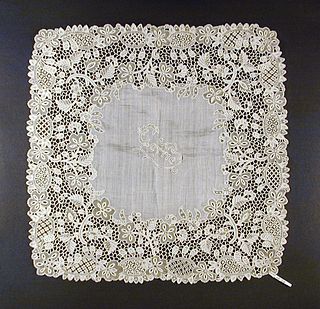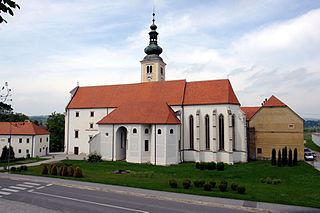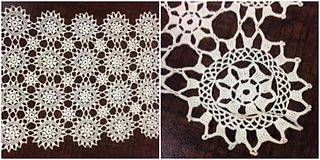
Needlework is decorative sewing and textile arts handicrafts. Anything that uses a needle for construction can be called needlework. Needlework may include related textile crafts such as crochet, worked with a hook, or tatting, worked with a shuttle.

Lace is a delicate fabric made of yarn or thread in an open weblike pattern, made by machine or by hand. Generally, lace is split into two main categories, needlelace and bobbin lace, although there are other types of lace, such as knitted or crocheted lace. Other laces such as these are considered as a category of their specific craft. Knitted lace, therefore, is an example of knitting. This article considers both needle lace and bobbin lace.

A corset is a support garment worn to hold and train the torso into the desired shape and posture. They are traditionally constructed out of fabric with boning made of whalebone or steel, a stiff panel in the front called a busk which holds the torso rigidly upright, and some form of lacing which allows the garment to be tightened. Corsets were an essential undergarment in European women's fashion from the 17th century to the early 20th century. In the 17th and 18th centuries they were commonly known as "stays" and had a more conical shape. This later evolved into the curvaceous 19th century form which is commonly associated with the corset today. By the beginning of the 20th century, shifting gender roles and the onsets of World War I and II led the corset to be largely discarded by mainstream fashion.

Bobbin lace is a lace textile made by braiding and twisting lengths of thread, which are wound on bobbins to manage them. As the work progresses, the weaving is held in place with pins set in a lace pillow, the placement of the pins usually determined by a pattern or pricking pinned on the pillow.

Needle lace is a type of lace created using a needle and thread to create hundreds of small stitches to form the lace itself.

A bobbin or spool is a spindle or cylinder, with or without flanges, on which yarn, thread, wire, tape or film is wound. Bobbins are typically found in industrial textile machinery, as well as in sewing machines, fishing reels, tape measures, film rolls, cassette tapes, within electronic and electrical equipment, and for various other applications.

Tightlacing is the practice of wearing an increasingly tightly laced corset to achieve cosmetic modifications to the figure and posture or to experience the sensation of bodily restriction. The process originates in mid-19th century Europe and was highly controversial. At the peak of the prevalence of tightlacing, there was much public backlash both from medical doctors and dress reformers, and it was often ridiculed as vain by the general public. Due to a combination of evolving fashion trends, social change regarding the roles of women, and material shortages brought on by World War I and II, tightlacing, and corsets in general, fell out of favor entirely by the early 20th century.

Macramé is a form of textile produced using knotting techniques.

Tønder lace is a point-ground type of handmade bobbin lace identified with the Tønder region of Denmark since about 1850, although lace of many types has been made there since as early as 1650. The term is also used more broadly, to refer to any bobbin lace made in Denmark.

Youghal lace is a needle lace inspired by Italian needle lace and developed in Youghal, County Cork, Ireland.

Broderie anglaise is a whitework needlework technique incorporating features of embroidery, cutwork and needle lace that became associated with England, due to its popularity there in the 19th century.

Carrickmacross lace is a form of lace that may be described as decorated net. A three-layer 'sandwich' is made consisting of the pattern, covered with, first, machine-made net and then fine muslin, through which the pattern can be seen. A thick outlining thread is stitched down along the lines of the pattern, sewing net and fabric together. Loops of thread known as 'twirls' are also couched along the outer edge. The excess fabric is then cut away. Some of the net is then usually decorated further with needle-run stitches or small button-holed rings known as 'pops'. Occasionally bars of buttonhole stitches are worked over fabric and net before both are cut away.
Linens are fabric household goods intended for daily use, such as bedding, tablecloths, and towels. "Linens" may also refer to church linens, meaning the altar cloths used in church.

Lepoglava is a town in Varaždin County, northern Croatia, It is located 32 km southwest of Varaždin, 7 km west of Ivanec, and 22 km northeast of Krapina.

Brussels lace is a type of pillow lace that originated in and around Brussels. The term "Brussels lace" has been broadly used for any lace from Brussels; however, strictly interpreted, the term refers to bobbin lace, in which the pattern is made first, and the ground, or réseau added, also using bobbin lace. Brussels lace is not to be confused with Brussels point, which is a type of needle lace, though sometimes also called "Brussels lace".

The corset controversy was a moral panic and public health concern around corsets in the 19th century.

Irish lace has always been an important part of the Irish needlework tradition. Both needlepoint and bobbin laces were made in Ireland before the middle of the eighteenth century, but never, apparently, on a commercial scale. It was promoted by Irish aristocrats such as Lady Arabella Denny, the famous philanthropist, who used social and political connections to support the new industry and promote the sale of Irish lace abroad. Lady Denny, working in connection with the Dublin Society, introduced lace-making into the Dublin workhouses, especially among the children there. It is thought that it was an early form of Crochet, imitating the appearance of Venetian Gros Point lace.

Greek lace is considered one of the earliest forms of all lace. Some types of Greek lace include reticella, Roman lace, cutwork, Venetian guipure, and Greek point lace

Maltese lace is a style of bobbin lace made in Malta. It is a guipure style of lace. It is worked as a continuous width on a tall, thin, upright lace pillow. Bigger pieces are made of two or more parts sewn together.

Ipswich lace is a historical fashion accessory, the only known American hand-made bobbin lace to be commercially produced. Centered in the coastal town of Ipswich, Massachusetts north of Boston, a community of lacemaking arose in the 18th century. Puritan settlers to the area likely made and wore lace as early as 1634, because Sumptuary laws from the early colonial records indicate this activity. In fact, the earliest known record of the act of lacemaking in the region comes from a court case in 1654 associated with the home of Governor John Endicott. An indentured servant in the household accused the governor's son Zerubbabel with assault, which occurred while she was working at her lace cushion. Earliest known records of the commercial production indicate that lace produced by local women was used to barter for goods in the 1760s, as denoted by ledger account books belonging to local merchants. These laces were sold in the region from Boston to Maine.


















